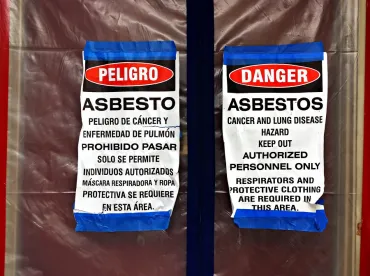Big changes are coming to a regulation that, while well meaning, cost businesses selling products in California more than $50M in 2017 and similar amounts in prior years. California’s Safe Drinking Water and Toxic Enforcement Act of 1986, more commonly known as Proposition 65 (“Prop 65”), is getting a makeover – new warnings, shifting burdens and more specific internet and catalog safe harbor requirements that take effect August 30, 2018. Unfortunately, the makeover will not deter Prop 65 “enforcers” and their counsel who will continue to burden business with enforcement litigation that does little to further the stated goals of the regulation. And now with the new internet and catalog warning requirements, these individuals can “hunt” from the comfort of their own homes. What does this all mean? Now more than ever, businesses that sell products in California should seek advice from experienced counsel to help them navigate and comply with this challenging and changing regulation.
Background and Current Version of Prop 65 Safe Harbor Warnings
California voters approved Prop 65 in 1986 amidst growing concerns about the prevalence of toxic chemicals in drinking water and everyday products. Prop 65 requires the state to publish a list of chemicals known to cause cancer and birth defects or other reproductive harm. When the original list was published in 1987 it contained 29 chemicals. Today, the list has grown to over 1,000 chemicals and continues to be updated each year. The Office of Environmental Health Hazard Assessment (OEHHA) administers the Prop 65 program and it is enforced by the California Attorney General’s Office, among others. The list includes synthetic and naturally occurring chemicals that can be found in common household products, food, drugs, dyes, pesticides, and solvents. Listed chemicals also include those used in manufacturing and construction and byproducts of chemical processes, such as car exhaust and smokers outside an apartment complex. Under Prop 65, businesses with 10 or more employees must provide “clear and reasonable” warnings before knowingly and intentionally exposing individuals to chemicals on the list.
Based on regulations issued by OEHHA in 2008, Prop 65 currently only requires warning language that is broad and general:

Depending on the context, the warning can be in the form of a label on a product, a sign at a workplace, notices distributed at a specific location, or published warnings in a newspaper. After a chemical joins the list, businesses have 12 months to comply with warning requirements. Violations of Prop 65 can lead to penalties of $2,500 per day per violation.
Changes to Warning Language Regulations Taking Effect in 2018
In August 2016, OEHHA issued new regulations for “clear and reasonable” warnings. The new regulations will be effective on August 30, 2018, and will apply to products manufactured after that date, although businesses can begin implementing the new warning language at any time. A consumer product that is manufactured prior to August 30, 2018, and labeled with a warning that complies with the 2008 regulations, is deemed to comply with the new regulations.
The new warning regulations are much more specific than those of the 2008 version. The new regulations now require that warnings specifically identify at least one listed chemical in the product. Indeed, the warnings are now so specific that there are different versions depending on whether the product contains only listed reproductive toxicants, only listed carcinogens, both listed reproductive toxicants and listed carcinogens, or a listed chemical that is both a carcinogen and reproductive toxicant.

The new regulations provide simplified safe-harbor language for warnings that are placed directly on a product or a product’s immediate packaging. for example:

However, companies that use the so-called “short form” or “on product” warning face different type size requirements. This warning “must be in a type size no smaller than the largest type size used for other consumer information on the product,” with a minimum of 6-point type.
The New “Gotcha” – Internet and Catalog Warnings
Historically, for product purchases made over the internet, a company needed to provide only a general broad warning at the bottom of the company website to comply with Prop 65 or have a compliant label on the product being sold (even if not seen by the purchaser). No more. Now, each product that requires a warning must have that warning “closely associated” with it on the product webpage. OEHHA has provided guidance on how internet retailers can comply with the new regulations. Specifically, website warnings must either be (1) placed on the product’s display page, (2) given via hyperlink using the word “WARNING” placed on the product display page, or (3) displayed, with a tie to the product for which the warning is being given, to the consumer before the purchase is completed (such as having the warning appear when the shopper enters a California zip code into the shipping information fields during the checkout process). A warning does not satisfy Prop 65’s requirements if the purchaser is required to search for it.
While catalogs are far less prevalent today than in years past, there are many still in circulation and they are subject to updated warning requirements as well. Similar to the new internet warnings, catalog warnings must be “closely associated” with the product being warned about. Given that there are no “hyperlinks” on paper catalog pages, these requirements will necessitate some creativity on the part of catalog producers to fit the requisite warning language into each page’s layout. It is not acceptable to provide a list of warnings in a glossary at the end of the catalog; rather, each product must have the warning on the product page.
This change in the regulations is likely to impact both public and private enforcement actions. Private “bounty hunter” efforts previously have focused on failures to provide in-store or on-product warnings. Now, many professional Prop 65 plaintiffs and their lawyers will instead search the internet for improper or absent website warnings. Given that the revised regulations apply only to products manufactured after August 30, 2018, it will be difficult for plaintiffs to know conclusively whether any particular product on the website requires the new or old warnings and any manufacturer or retailer who receives a notice of violation of Prop 65 should immediately determine the manufacturing date of the implicated product to determine which version of the Prop 65 warning requirements applies.
Shifting Responsibilities – Manufacturers Have the Burden
The revised regulations state that OEHHA’s goal is to “minimize the burden on retail sellers of consumer products, to the extent practicable….” To satisfy this directive, the new regulations place the primary responsibility for providing warnings on “product manufacturers, producers, packagers, importers, suppliers or distributors.” These businesses must either provide a warning on the product or provide a notice and warning materials to the “authorized agent” for a retail seller and receive a confirmation that the materials were received. From there, the retailer is responsible for placement and maintenance of the warning materials, including placement in the appropriate locations on product webpages. The burden to warn shifts to a retailer who is selling a product under its own brand or license, knowingly introduces listed chemicals into the product, obscures or alters the manufacturer’s warning or knows the product requires a warning but the manufacturer is not subject to Prop 65.
Tailored Warnings and Environmental/Facility Exposure Warnings
The revised Prop 65 regulations also include new, highly specific, safe harbor warning requirements for certain products and facilities.
Tailored warnings are required for products as disparate as alcohol, furniture, and recreational vessels. And each of these products has its own set of warning requirements. For example, the new tailored warning for alcohol reads:

Areas where a person may be exposed to alcoholic beverages must have an “8 1/2 by 11 inch sign in no smaller than 22-point type, placed at eye level so that it is readable and conspicuous to customers as they enter the area or areas where, by permit or license, alcoholic beverages are served.”
There are many similar examples of tailored warnings for a number of additional products and product categories.
Tailored warnings are also now required for specific “facilities.” Places such as amusement parks, designated smoking areas and vehicle repair facilities also require the tailored warnings. Enclosed parking facilities will require this specific tailored warning:

Manufacturers have the primary responsibility for providing the tailored warnings for products. Retailers must use the warnings provided by manufacturers and confirm they received notice. Owners and facility management have the responsibility for the development, placement and maintenance of environmental and facilities warnings. To the extent an OEHHA-provided tailored warning is found to be unsatisfactory, a business may request the implementation of a customized “tailored warning” which OEHHA will consider and further amend Prop 65 as necessary.
Private Enforcement Litigation Will Increase
Over the past three years, the number of private Prop 65 enforcement actions and the total value of settlements and judgments have remained relatively flat – approximately 700 actions per year for approximately $50-$60 million in settlements and judgments. The new regulations – particularly the new requirements for internet safe harbor warnings and the relative ease of hunting for noncompliant websites – are likely to bring a significant uptick in the 2019 private enforcement numbers.
With only a few months remaining to comply, businesses need to act now to understand the risks and complexities associated with the new Prop 65 regulations and to take steps to comply.





 />i
/>i

